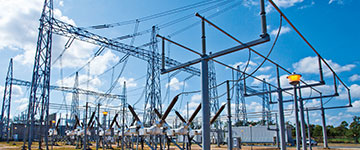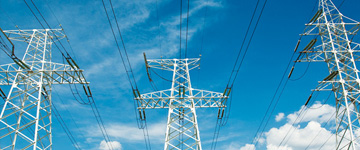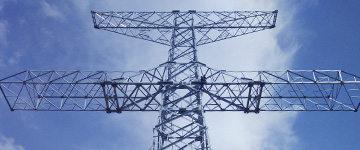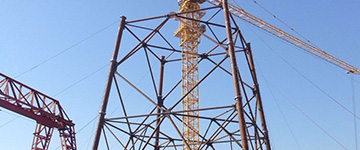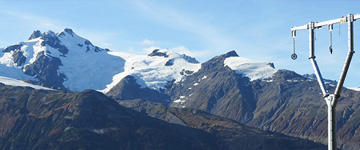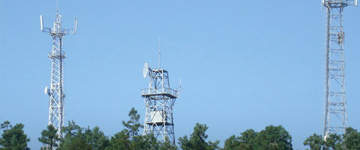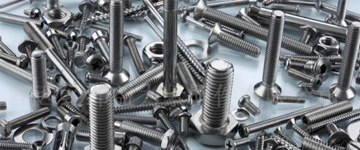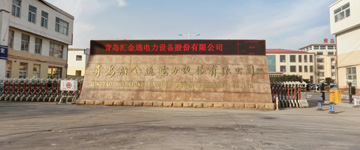Electricity data in the first half of the year reflect steady and progressive economic operation.
Polaris Transmission and Distribution Network News: Electricity data is a barometer reflecting economic operation. This paper analyses the data of power supply and demand in the first half of the year, and combs the characteristics of power operation from two aspects: supply side and demand side.
1. Overall, the growth of electricity consumption in the whole society reflects the overall stability of China's economic operation.
Generally speaking, the fluctuation range of electricity consumption growth is larger than that of economic growth. In the first half of the year, the electricity consumption of the whole society in the State Grid Business Zone (the same below) was 2680.4 billion kWh, an increase of 4.5% over the same period last year, and a decrease of 4.2 percentage points over the same period last year. Quarterly, the growth rates in the first and second quarters were 5.0% and 3.9% respectively. Generally speaking, the growth of electricity consumption in the first half of this year is in line with the expectation at the beginning of this year. The steady growth of electricity consumption in the first quarter and the slowdown of electricity consumption in the second quarter reflect the good start of the first quarter and the downward pressure on the economy in the second quarter. In the first half of the year, China's GDP grew by 6.3% year on year. Quarterly, the growth rate in the first quarter was 6.4%, which was the same as that in the fourth quarter of 2008. The growth rate in the second quarter was 6.2%, which was 0.2 percentage points slower than that in the first quarter.
2. Structurally speaking, the consumption of electricity in tertiary industry and residents'daily life is of great importance to the whole society.
The contribution of electricity consumption growth has increased significantly.
In the first half of the year, the electricity consumption of the secondary industry increased by 2.3%, and the growth rate decreased by 4.3 percentage points over the same period. This is the main reason for the decline of the whole society's electricity consumption growth in the first half. The contribution rate to the growth of the whole society's electricity consumption is 35.7%, which is 17.6 percentage points lower than that of the previous year, accounting for 67.7% of the total society's electricity consumption and 1.4 percentage points lower than that of the previous year.
The electricity consumption of the tertiary industry and residents increased by 9.4% year-on-year, and the growth rate decreased by 4.9% and 4.2% year-on-year, mainly due to the lower temperature in the first quarter of last year, the advance of high temperature in summer and the higher power base. The contribution rates of tertiary industry and residents'life to the growth of electricity consumption in the whole society are 33.3% and 29.8% respectively, up 8.6% and 8.7% year-on-year, which have become the important driving force for the growth of electricity consumption. The proportion of electricity consumption in the whole society is 16.6% and 14.8% respectively, which are up 0.7% year-on-year, reflecting the continuous optimization of electricity consumption structure. In the tertiary industry, the electricity consumption of productive and living services has maintained rapid growth, with growth rates of 9.9% and 9.8% respectively.
The small increase in industrial electricity consumption reflects the stability of industrial production. In the first half of the year, industrial electricity consumption increased by 2.1% compared with the same period last year, and the growth rate dropped by 4.5 percentage points. Quarterly, the growth rates in the first and second quarters were 1.9% and 2.2%, respectively. In June, industrial electricity consumption increased by 3.8% year-on-year, up by 3.7 percentage points annually compared with May. In the first half of the year, the value added of industries above scale increased by 6.0% year on year, and the growth rate remained within a reasonable range. In June, the growth rate increased by 6.3% year on year. The growth rate rose by 1.3 percentage points annually compared with May.
The growth rate of electricity consumption in high-tech and equipment manufacturing industry has fallen sharply, but the growth of added value has accelerated, reflecting the continuous promotion of the transformation of new and old industrial kinetic energy. In the first half of the year, the electricity consumption of the high-tech and equipment manufacturing industry increased by 3.7% compared with the same period last year, and the growth rate dropped by 8.9 percentage points, but it was still 1.6 percentage points higher than that of the industrial power consumption. Among them, the power consumption of new energy vehicle manufacturing, photovoltaic equipment and components increased by 47.0% and 25.6% respectively. The added value of high-tech manufacturing industry increased by 9.0% year-on-year, faster than 3.0 percentage points of above-scale industries and 1.2 percentage points faster than that of the first quarter.
The growth rate of total electricity consumption in the four high energy-consuming industries is lower than that of industrial electricity consumption. Among them, the growth rate of electricity consumption in the ferrous metal industry has dropped significantly, the growth rate of electricity consumption in the chemical and building materials industries has increased year on year, and the electricity consumption in the non-ferrous metal industry has maintained a negative growth. In the first half of the year, the total electricity consumption of the four high-energy-consuming industries, chemical industry, building materials, ferrous metal and non-ferrous metal, was 717.5 billion kWh, up 1.3% year-on-year, and the growth rate was 0.6 percentage points lower than that of the same period last year. Specifically, the electricity consumption of chemical industry increased by 2.4% year on year, the growth rate increased by 1.4 percentage points compared with the same period last year; the electricity consumption of building materials industry increased by 7.1% year on year, the growth rate increased by 2.7 percentage points compared with the same period last year; the electricity consumption of ferrous metal industry increased by 4.0% year on year, the growth rate decreased by 6.5 percentage points compared with the same period last year; and the use of non-ferrous metals industry decreased by 6.5 percentage points. Electricity consumption decreased by 5.2% year on year, and the growth rate increased by 0.4 percentage points compared with the same period last year. The proportion of electricity consumption in the four high-energy-consuming industries in the whole society is 26.8%, which is 0.7 percentage points lower than that in the same period last year. The total electricity consumption of the four high-energy-consuming industries increased by 3.5% in June compared with the same period last year, and the growth rate was 1.9 percentage points higher than the same period last year.
3. The growth rate of electricity consumption in 36 major regions decreased year on year, and electricity consumption in 23 provincial power grids increased positively.
In the first half of the year, the electricity consumption in North China, East China, Central China, Northeast China, Northwest China and Southwest China increased by 5.0%, 3.0%, 5.5%, 2.7%, 4.5% and 8.3% respectively, and the growth rate decreased by 0.5%, 7.2, 4.3, 5.3, 5.1 and 3.6 percentage points over the same period last year, especially in East China, Northeast China and Northwest China. Among them, the sharp decline in the growth rate of power consumption in East China is mainly caused by the low industrial power consumption. Affected by Sino-US trade friction, the growth rate of industrial power consumption in East China declined sharply, increasing by only 0.2% in the first half of the year and dropping by 7.4 percentage points. The growth of industrial and residential power consumption in Northeast China is due to the lack of new economic growth points. Slowly, the growth rate of tertiary industry is relatively high, but still drops by 8.3 percentage points compared with the same period last year. The decline of electricity consumption in Northwest China is mainly attributed to the low rate of high energy consumption. In the first half of the year, the negative growth rate of high energy consumption in Northwest China was -1.6%, which was 5.2 percentage points lower than that in the same period last year, of which both ferrous and non-ferrous metals showed negative growth. The growth rates were - 3.6% and - 3.1% respectively. In the first half of the year, except Qinghai (-2.8%), Mengdong (-2.7%), Gansu (-0.7%) and Shanghai (-0.1%), the electricity consumption of the 23 provincial power grids increased positively, with Tibet's power grid growing at the highest rate (16.6%) mainly driven by the rapid growth of the tertiary industry and residential electricity consumption.
4. The scale of net additional installers decreased year on year, and the proportion of non-fossil energy installers increased further.
In the first half of the year, the net installed capacity was 36.23 million kilowatts, a decrease of 4.74 million kilowatts compared with the same period last year. Among them, net hydropower, thermal power, nuclear power, wind power and solar power accounted for 2.2%, 46.7%, 3.5%, 19.7% and 28.0% respectively. By the end of June, the installed capacity of power generation was 1.51 billion kW, an increase of 6.1% over the same period last year. Among them, the installed capacity of non-fossil energy is 572.96 MW, which is 10.3% higher than that of the same period last year, accounting for 38.0% of the total installed capacity, an increase of 1.4 percentage points over the same period last year.
5. Power generation increased steadily, and the proportion of non-fossil energy power generation increased significantly.
In the first half of the year, the power generation capacity in the State Grid Business Area was 2640.2 billion kWh, an increase of 4.3% over the same period last year. Among them, solar power, nuclear power, hydropower, wind power and thermal power increased by 28.7%, 24.0%, 13.0%, 10.6% and 0.6% respectively. Non-fossil energy power generation is 728.9 billion kWh, accounting for 27.6% of the total power generation, an increase of 2.7 percentage points over the same period last year.
6. The utilization hours of power generation equipment decreased year on year, while the utilization hours of hydropower and solar power increased.
In the first half of the year, the average utilization hours of power generation equipment in the operating areas of the State Grid were 1770 hours, a decrease of 44 hours compared with the same period last year. Among them, the utilization hours of hydropower and solar power are 1640 and 587 hours respectively, increasing by 173 and 10 hours respectively, while the utilization hours of thermal power, nuclear power and wind power are 2064, 3414 and 1091 hours respectively, reducing by 71, 111 and 33 hours respectively.
In the third quarter, the economic situation is still complex and grim, and the external uncertainties increase, which has a greater impact on business operations and market expectations. By intensifying counter-cyclical regulation and strengthening policy implementation, China's economic growth is expected to stabilize. In terms of climate, this year's rainfall is on the high side. It is estimated that the temperature in summer is generally lower than that in the previous year, which restricts the growth of air conditioning cooling and electricity consumption. Generally speaking, the growth rate of electricity demand in the third quarter is expected to be roughly the same as that in the second quarter, showing a steady growth trend.



